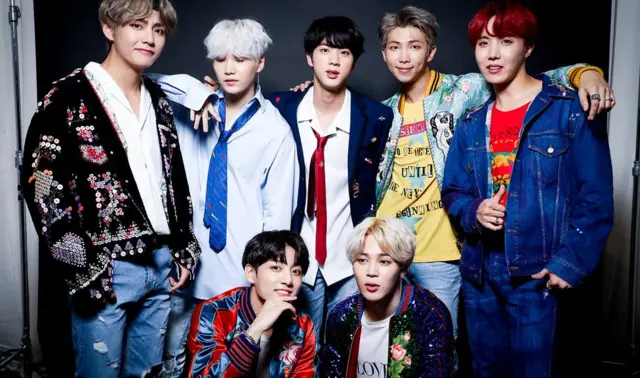Physical Address
304 North Cardinal St.
Dorchester Center, MA 02124
Physical Address
304 North Cardinal St.
Dorchester Center, MA 02124

K-pop is music from Korea. It has fun songs and cool dance moves. Many people all over the world love K-pop!
K-pop started in Korea a long time ago. Groups like H.O.T and S.E.S were some of the first K-pop stars. Today, groups like BTS and BLACKPINK are very famous.
K-pop songs are fun to listen to. The singers dance really well and wear cool outfits. Their music videos are colorful and exciting!
K-pop fans love their favorite singers. BTS fans are called ARMY, and BLACKPINK fans are called BLINKs. Fans watch music videos and support their favorite groups.
K-pop is not just music. Many people like K-pop fashion and Korean culture too. Some people even learn the Korean language because of K-pop!
K-pop keeps growing. More people around the world love it. New music, fun concerts, and cool videos make K-pop exciting. K-pop will be popular for a long time!

K-Pop: Fun Music from Korea
K-pop, or Korean pop music, is popular all over the world. It has fun songs, cool dance moves, and bright music videos. K-pop started in South Korea, but now people everywhere love it!
K-pop began in the 1990s. A group called Seo Taiji and Boys mixed Western music with Korean music. Later, big companies like SM, YG, and JYP Entertainment started training young singers and dancers. Groups like H.O.T, S.E.S, and Shinhwa became the first big K-pop stars.
Later, groups like BIGBANG, Girls’ Generation, and Super Junior made K-pop even bigger. Today, groups like BTS, BLACKPINK, and Stray Kids are famous all over the world.
K-pop is popular because of its great music and performances. K-pop idols train for years before they start. They learn to sing, dance, and even speak different languages.
K-pop music videos are colorful and exciting. The singers wear cool outfits and do amazing dance moves. Many K-pop idols also work with famous fashion brands like Chanel and Dior.
K-pop fans are very loyal. Fans of BTS are called ARMY, and fans of BLACKPINK are called BLINKs. Fans help their favorite groups by watching their music videos and voting for them in contests.
Social media helps K-pop grow. Platforms like Twitter, TikTok, and YouTube let fans and idols talk to each other. K-pop idols also use apps like Weverse and V Live to connect with fans.
K-pop is not just music. It also influences fashion, beauty, and even language. Many people start learning Korean because of K-pop. Korean skincare products and dramas are also becoming very popular.
Some K-pop groups have members from different countries. This makes K-pop more diverse and welcoming to fans from all over the world.
K-pop is always changing and growing. New technology like virtual reality is making concerts even more exciting. K-pop idols are also working with Western artists to create new music styles.
Even though K-pop idols work very hard and have busy schedules, K-pop is still growing. With its creative ideas and strong fans, K-pop is more than just music—it is a worldwide movement that will keep growing for years!

K-pop, short for Korean pop music, has grown into a global phenomenon, captivating audiences worldwide with its infectious melodies, stunning visuals, and meticulously choreographed performances. Originating in South Korea, this genre has transcended cultural boundaries, creating a massive international fanbase and reshaping the global music industry.
K-pop traces its roots back to the early 1990s, with groups like Seo Taiji and Boys revolutionizing the Korean music scene by blending Western pop, rock, and hip-hop influences with Korean lyrics and themes. Over time, entertainment companies such as SM Entertainment, YG Entertainment, and JYP Entertainment began training aspiring artists through rigorous programs, leading to the emergence of well-known first-generation idols like H.O.T, S.E.S, and Shinhwa.
As the industry evolved, second-generation groups such as BIGBANG, Girls’ Generation, and Super Junior gained international recognition, laying the foundation for the genre’s expansion beyond South Korea. Today, third and fourth-generation groups like BTS, BLACKPINK, and Stray Kids dominate global music charts, showcasing the genre’s ability to innovate and appeal to diverse audiences.
One of the primary reasons for K-pop’s global appeal is its unique and strategic approach to music production and artist development. Unlike many Western artists who rely heavily on personal artistic expression, K-pop idols undergo extensive training in singing, dancing, language skills, and even media handling before debuting. This level of preparation ensures high-quality performances that consistently impress fans.
Additionally, K-pop’s strong emphasis on visuals and fashion plays a significant role in its popularity. Music videos are carefully crafted with high-budget cinematography, elaborate sets, and intricate dance routines, making them visually stunning. The fashion trends set by K-pop idols often influence global markets, with many artists becoming ambassadors for luxury brands like Chanel, Dior, and Louis Vuitton.
K-pop fandoms are a driving force behind the industry’s success. Dedicated fan bases, such as BTS’s ARMY and BLACKPINK’s BLINKs, actively promote their favorite artists by streaming music, organizing voting campaigns, and supporting charitable causes in the idols’ names. Social media platforms like Twitter, TikTok, and YouTube have further amplified K-pop’s reach, allowing real-time interactions between idols and fans worldwide.
Live-streamed concerts, variety shows, and exclusive content on platforms like Weverse and V Live provide fans with a sense of closeness to their favorite idols. This digital engagement has contributed to the rapid rise of K-pop in markets like the United States, Europe, and Latin America.
K-pop’s influence extends beyond music, impacting various aspects of global culture, including fashion, beauty, and even language. The Korean Wave, or Hallyu, has increased interest in Korean culture, leading to a surge in Korean language learners and an increased demand for K-dramas, Korean skincare products, and Korean cuisine worldwide.
Moreover, K-pop has played a role in breaking down barriers in the global entertainment industry. With non-Korean members in groups like NCT, TWICE, and ENHYPEN, K-pop has embraced diversity and inclusivity, appealing to fans from different cultural backgrounds.
As K-pop continues to evolve, its future looks promising with the integration of new technologies such as artificial intelligence, virtual reality concerts, and AI-generated idols. With more artists collaborating with Western musicians and exploring new sounds, the genre is poised for even greater success in the coming years.
Despite facing challenges such as intense industry pressure and mental health concerns among idols, K-pop remains a powerful force in the entertainment world. With its dedicated fanbase and ability to adapt to changing trends, it is clear that K-pop is more than just a music genre—it is a global cultural movement that will continue to shape the future of entertainment.